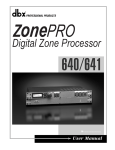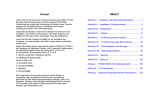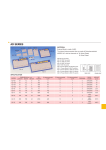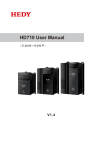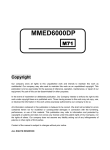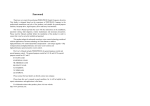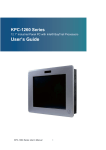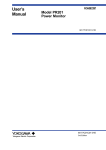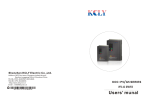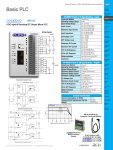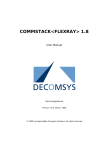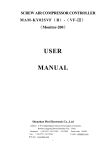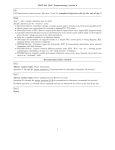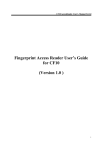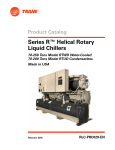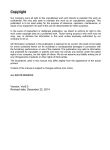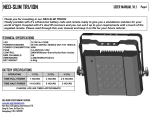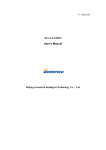Download PI7500 manual - SIPAL Automation
Transcript
Foreword Thank you very much for purchasing PI7500 Family Frequency Inverters. This family is designed based on the experience of POWTRAN Company in the professional manufacture and sale of the products, and it is with high performance and with simple functions. This User’s Manual provides the users with the instructions on the installation, parameter setting, fault diagnosis, routine maintenance and necessary precautions. Please read the Manual carefully before the installation of the product in order to ensure that it can be correctly installed and operated. This User’s Manual includes the G series: G: GENERAL LOAD Please contact the local dealers or directly contact our company. Please keep this user’s manual in good condition, for it will be helpful to the repair, maintenance, and applications in the future. For information about other product, please visit our website: http://www.powtran.com. POWTRAN 2007.4 CONTENTS SECTION I. INSPECTION AND SAFETY PRECAUTIONS....................... 1 SECTION II. INSTALLATION & STANDBY CIRCUIT................................ 4 SECTION III. OPERATING KEYBOARD ................................................. 10 SECTION IV. TEST RUNNING ................................................................ 18 SECTION V. FUNCTION PARAMETER TABLE...................................... 20 SECTION VI. FUNCTION PARAMETER DESCRIPTION.......................... 32 SECTION VII. FAULT DIAGNOSIS AND SOLUTIONS.............................. 66 SECTION VIII. STANDARD SPECIFICATIONS.......................................... 68 SECTION IX. MAINTENANCE................................................................. 73 SECTION X. OPTIONS........................................................................... 76 Section I. Inspection and Safety Precautions Section I. Inspection and Safety Precautions 1-2. Safety Precautions ※ Never connect the A.C. power supply to the output terminals (U, V, W) of the frequency inverter. POWTRAN PI7500 frequency inverters have been tested and inspected before leaving the manufacturer. Before unpacking the product, please check if its package is damaged due to careless transportation, and if the specifications and type of the product complies with the order. Please contact the supplier of POWTRAN products if any problems are found. ※ Fix and lock the panel before supplying power so as to avoid the danger caused by the poor capacity or other components inside the inverter. ※ After the power supply is switched on, do not perform wiring or check, etc. 1-1. Inspection after Unpacking ※ Don’t touch the circuit boards or its parts or components in the inverter when it is powered, so as to avoid danger of electric shock. ※ If the power supply is switched off, do not touch the PCB or other parts inside the inverter within 5 minutes after the keyboard indicator lamp goes off, and you must check by using the instrument that the inverter has completely discharged all its capacity before you start to work inside the inverter. Otherwise, there will be the danger of electric shock. ※ The static electricity in human body will cause serious damage to the MOS field effect transistor in the inverter. Please keep your hands away from the PCB, IGBT and other internal parts before taking actions to prevent static electricity. Otherwise, faults may be caused. ※ In use, the earthing terminal (E or ) of the frequency inverter must be grounded to the earthing connections correctly and securely according to the national electrical safety specifications and other applicable standards. ※ Please don’t shut off the unit by turning off the power supply. Turn off the power supply after the motor has stopped its operation. ※ Meet CE standard with EMI filter. ※ Inspect that the contents are complete (one PI7500 frequency inverter, one Operation Manual). ※ Check the nameplate on the side of the frequency inverter to ensure that the product you have received is right the one you ordered. Instructions on name plate: (giving 11.5kW/380V as example) TYPE: PI7500 1R5G32 SOURCE: 3φ 380V 50-60Hz OUTPUT: 1.5KW 3.7A 0.00-800.0Hz Z0601A00001 POWTRAN TECHNOLOGY CO.,LTD. Model designation: 1-3. Application 1 ※ Powtran inverter is generally applied to 3 phase AC asynchronism motors. ※ Powtran inverter is applied to the admisive occasion, the occasion where is not admissive may lead to fire, electric shock, explosion and so on. ※ If the inverter seizes up when it is applied to the equipment which may 2 Section I. Inspection and Safety Precautions lead danger (e.g. lift tools of transportation, aviation system, saftety equipment, etc), it should be managed carefully. Do inquire the factory when it happens. Only the well-trained personnel are allowed to use this unit, and such personnel must read through the parts of this manual relating to the safety, installation, operation and maintenance before using the unit. The safe operation of this unit depends on correct transport, installation, operation and maintenance! Section II. Installation & Standby Circuit 2-1. Conditions for Use 1) Ambient temperature -10℃~40℃. 2) Avoid electromagnetic interference and keep the unit away from the interference source. 3) Prevent dropping water, steam, dust, powder, cotton fiber or fine metal powder from entering it. 4) Prevent oil, salt and corrosive gas from entering it. 5) Avoid vibration. 6) Avoid high temperature and moisture and avoid being wetted due to raining, with the humidity below 90%RH (not dewing). 7) Prohibit the use in the dangerous environment where inflammable or combustible or explosive gas, liquid or solid exists. 2-2. Installation 150MM The frequency inverter must be installed by wall hooking in the indoor room with adequate ventilation, with enough space left between it and the adjacent objects or damper (walls) surrounding it, as shown in the below figure: + 50MM - P RG FWD SET 50MM REV JOG ST OP R ESET 150MM E SC DI SP L 3 4 Section II. Installation & Standby Circuit 2-3. Wiring Section II. Installation & Standby Circuit (1)0.4~0.75KW G1 The wiring of frequency inverter includes two parts: main circuit and control circuit. The user must ensure correct connections according to the following connection diagram. (2) Other types of PI7500 2-4-2. Terminal Function Terminal R/L1 S/L2 T/L3 E/PE RB, RB′ U/T1 V/T2 W/T3 Description Functions Power input for frequency inverter Connected to 3-phase power (Single input connected to R ,T) Grounding point Connection point for braking resistance Grounded to the earth 3 Phase Output Connected to 3-phase motor 2-5. Control Circuit Terminals 2-5-1 Control Circuit Terminals distribution. 2-4. Main Circuit Terminals: 2-4-1. PI7500 Main Circuit Terminals 5 6 Class Terminal COM FWD Description Function Common point for control commands Forward rotation command F05=1, Edge triggers(F62=0),and runs forward in falling edge, stops in rising edge F05=3, Level triggers(F62=0/1/2) REV Reverse rotation command F05=1, Edge triggers (F62=0), and runs reverse in falling edge, stops in rising edge. F05=3, Level triggers(F62=0/1/2) JOG Control signal SS1 SS2 Output signal SS3 Jog command Level triggers, and executes JOG command in a lower level, stops in a high level Multi-step speed/acceleration F63=1/2,Short-circuited to COM to compose 7-step speed and acceleration, level triggers, effective in a lower level Rising/Falling control F04=4,for rising control Frequency mode switch Switch the frequency setting mode with SS2, SS3 Multi-step speed/acceleration Power Supply +10V, GND V2 Voltage Input signal Range is adjustable in 0~10V I2 Current Input signal Range is adjustable in 0~20mA V1 Power Supply of DA1 Used for Power Supply when DA1 selects current output DA1 Multi-function analog signal output 1 0~10/1~5VDC 0~20/4~20mA 24V Power Positive terminal COM Common point Maximal output 24V/200mA. COM and V3 could not never be short-circuited. 2-6. Connection Precautions Don’t install power factor capacitance or resistance-capacitance absorbing device between the output terminals U, V, W of the frequency inverter. ※ To disassemble or replace the motor, the input power supply must be turned off for the frequency inverter. F63=1/2,Short-circuited to COM to compose 7-step speed and acceleration, level triggers, effective in a lower level ※ The motor or power supply can be switched on/off only after the inverter stops its output. ※ In order to minimize the effect of electromagnetic interference, a surge absorbing device should be installed if used electromagnetic contactor and relay, etc. is near to the frequency inverter. ※ For external control of frequency inverter, a isolation device should be used for the control lines or screened cable should be used. ※ A screened cable should be used as the signal connection line for input command and must be routed separately as well, and it had better be installed far from the main circuit. ※ When the carrier frequency is less than 3kHz, the distance between the frequency inverter and motor must not be greater than 50 meters (maximum). When it is above 4kHz, this distance should be reduced. The cable for this connection had better be laid in metal conduit. ※ If the frequency inverter is equipped with peripheral devices (such as filter, reactor), first measure its insulation resistance to the earth with 1000V megohm meter, and ensure the resistance value is not below 4MΩ. ※ If the frequency inverter must be started frequently, don’t switch off its Rising/Falling control F04=4,for falling control Frequency mode switch Switch the frequency setting mode with SS1,SS3 Multi-step speed/acceleration Short-circuited to COM to compose 7-step speed and acceleration, level triggers, effective in a lower level JOG control F63=3 COM is short-circuited to SS3 to execute JOG reverse command, to JOG to execute JOG forward command, and the previous JOG direction is invalid. Three-line running control F63=1/2,F62=2 Three-line terminal running for details Program running restart For selecting the program running restart mode F04=4,for falling control Frequency mode switch Switch the frequency setting mode with SS1,SS2 FRE Free Run Level triggers, and executes free stop command in a lower level RST Restore Level triggers, executes restore command in falling edge. Output signal 5 TA1-TC1 is open and TB1-TC1 is closed ( programmable) SPA/COM Output signal 1 V1,V3 ※ Rising/Falling control TA1/ TB1/TC1 Analog Input and output signal 2-5-2 Description to Control Circuit Terminals. Section II. Installation & Standby Circuit Auxiliary Power Section II. Installation & Standby Circuit Output open set signal when action (24VDC/50Ma) 7 8 Section II. Installation & Standby Circuit power supply, and the operator must start or stop the inverter by using the COM/FWD of the control terminal or Keyboard, in order to avoid damage to the bridge rectifier. Section III. ※ Don’t connect A.C. input power to the output terminals U, V, W of the frequency inverter. 3-1. Options of internal keyboard and external keyboard. ※ In order to prevent unexpected accidents, earthing terminal E or must be grounded to the earth securely (the grounding resistance should be below 100Ω). The cable size should be greater than half of below- mentioned corresponding cable size; otherwise current leakage will happen possibly. ※ For wiring of main circuit, please refer to national rule. ※ Capacity of the motor should be equal to or smaller than that of the inverter. Operating keyboard PI7500 could display on both the internal keyboard and external keyboard But it could not be operated by the internal keyboard and external keyboard simultaneously. And it could be shifted between these two keyboards by JP3 on the control card. The internal keyboard’s potentionmeter and external keyboard’s potentionmeter could not be operated simultaneously, but it could be shifted between these two potentionmeters by JP5 on the control card. JP3 2-7. Standby circuit When the fault or trip of the inverter may cause great loss or accident, please add the standby circuit. Note: confirm and test the running characteristic of the standby circuit, in order to ensure the industrial phase and the converter phase are in the same direction. JP5 Status Function key Controlled by external keyboard board Controlled by internal keyboard key Controlled by external potentionmeter Controlled by internal board potentionmeter Interlock relay P I7 5 0 0 7 K 5 C B .V 1 0 6 03 2 0 JP 3 JP 5 board DA1V JP 4 D A1 V1 9 key DA1C V2 I2 key board V 3 R E V C O M F W D J O G S S 1 S S 2 S S 3 F R E + 24 S P A T A 1 T B 1 T C 1 10 Section III. Operating keyboard Run Indication Light 3-2 PI7500 internal keyboard ? Section III. Operating keyboard % S Data unit Prompt Light Alarm Indication Light Specification and function description: RUN ALARM HZ A V ℃ Forward command light Data unit Prompt Light ℃ % Reverse command light FWD REV ALARM LED main display area S A HZ LED main display area V Paramiter setting/shift key Alarm Indication Light Run key STOP RESET RUN Stop/Reset key PRG Parameter Alternation Key (acc/reduction key) Escape/Display JP-10 UNIT UNIT S S S V V V 无单位 Hz S S ON V OFF 3-3 Optional external keyboard 3-3-1 JP3E7000 keyboard ? S V V % Specification and function description: °C A °C A S V V A % % °C A °C A Hz Hz % % °C A UNIT UNIT Hz Hz % °C A UNIT UNIT Hz % JOG STOP RESET Stop/Reset key Jog key Run key: ◇ drive forward. right upside of the keyboard,different status indicates different unit of the current parameter displayed in the LED .The units for the parameters as blow: °C ESC DISPL Function description DATE UNIT PROMPT LIGHT:It is formed up by 3 instruction light on the A Run key JP-01 This keyboard is the standard one for PI7500 Family inverter. % RUN SET Potentiometer ESC DISPL Acc. selection/ Parameter setting Hz Acc. selection/ Parameter setting Escape/Display SET Paramiter setting/shift key UNIT Parameter Alternation Key (acc/reduction key) PRG DIGITAL OPERATOR Hz Potentiometer DIGITAL OPERATOR S °C Stop/Reset key: ◇ Drive stops, resets after abnormity and confirms fault. Parameter Alternation//Acc./Dec Selection: ◇ When select parameter, press the SET key and add/reduction key, parameter code add/reduce 10 ◇ Restore modified value ◇ alternate the monitor object and monitor Escape/display ◇ Escape modifying the data of function parameters ◇ Escape of submenu or running into menu of status display from function menu ◇ Escape of fault status. Jog key ◇ On: jog ◇ Off: stop LED main display area ◇ Anterior 3 digits display the function code ◇ Latter 4 digits display the value as per the function code Data unit prompt Light: ◇ It is formed up by 3 instruction light on the right upside of the keyboard, different status indicates different unit of the current parameter displayed in the LED. The units 11 12 Section III. Operating keyboard for the parameters as blow: UNIT UNIT UNIT Hz Hz Hz °C A S S Hz none °C S V ON S V V % °C A °C A S V V A % % A °C A S V V V °C A °C A S Hz Hz % % ◇ ◇ UNIT UNIT Hz Hz % % % UNIT UNIT S °C OFF Alarm Indication Light Reverse command light ℃ % FWD REV ALARM HZ Escape/display ◇ Escape modifying the data of function parameters ◇ Escape of submenu or running into menu of status display from function menu ◇ Escape of fault status. Jog key ◇ On: jog ◇ Off: stop Data unit prompt Light: ◇ It is formed up by 3 instruction light on the right upside of the keyboard, different status indicates different unit of the current parameter displayed in the LED. The units for the parameters as blow: Specification and function description: Forward command light Restore modified value alternate the monitor object and monitor LED main display area ◇ Anterior 3 digits display the function code ◇ Latter 4 digits display the value as per the function code 3-3-2 JP5E7000 Keyboard ? Section III. Operating keyboard % LED main display area Run key RUN Parameter Alternation Key (acc/reduction key) Paramiter setting/shift key S Stop/Reset key DIGITAL OPERATOR STOP RESET none PRG JOG ESC DISPL SET Acc. selection/ Parameter setting Jog key S V V Hz S S ON V OFF Escape/Display JP-08 3-3-3 JP6E7000, JP6C7000 keyboard ? Specification and function description: Function description Run key: ◇ drive forward. Stop/Reset key: ◇ Drive stops, resets after abnormity and confirms fault. Parameter Alternation//Acc./Dec Selection: ◇ When select parameter, press the SET key and add/reduction key, parameter code add/reduce 10 13 14 S V V % °C A °C A S V V A % % °C A °C A Hz Hz % % °C A °C A S V Potentiometer °C UNIT UNIT Hz Hz % % A UNIT UNIT Hz Hz Hz V UNIT UNIT UNIT Data unit Prompt Light S A S °C Section III. Operating keyboard Section III. Operating keyboard ◇ Positive/Negative Value indication light Alarm Indication Light + ALARM - LED main display area Speed Status light * Display of running status Off:Stop status Flash:Acc/dec status On:Even Speed status FWS/REV Indication light SPEED-STATUS FWD REV LED main display area Paramiter setting/shift key Forward command light DIGITAL OPERATOR Parameter Alternation Key (acc/reduction key) PRG FWD Forward key SET REV Reverse key ESC DISPL STOP RESET Reverse command light Acc. selection/ Parameter setting Escape/Display JOG Jog key The upper LED main display area ◇ Display frequency, current, voltage, etc. Also display fault code, password right FWD/REV Indication light ◇ Display motor’s running state: forward or reverse. The nether LED main display area ◇ Display function code ◇ Display set frequency during running JP6E7000 is standard keyboard for PI7000, PI7100 Family inverter. JP6C7000 keyboard has the same structure and instruction with those of JP6E7000. The difference is that the lower LED display is changed into LCD display which displays the state and parameters in English. JP6C7000 is the optional keyboard for PI7000, PI7100. The following diagram is the description to JP6C7000 LCD display: The second monitor select F65=4 output voltage Stop/Reset key 200 16.0 9 PID set Value% JP-07 function description ● Forward key: ◇ Drive forward. Reverse key: ◇ Drive reverse. Stop/Reset key: ◇ Drive stops, resets after abnormity and confirms fault. Acc. Selection /Parameter setting: ◇ When select parameter, press the SET key and add/reduction key, parameter code add/reduce 10 ◇ Restore modified value ◇ alternate the monitor object and monitor Escape/display ◇ Escape modifying the data of function parameters ◇ Escape of submenu or running into menu of status display from function menu ◇ Escape of fault status. Off: stop LCD main display area For the 4 keypads, when the keypad is unlocked, press the and simultaneously for 3 seconds, the keypad is locked, LED displays normally after displaying “LoC” for 2 seconds; when the keypad is locked, press the and simultaneously for 3 seconds, the keypad is unlocked, LED displays normally after displaying “ULoC” for 2 seconds. 3-4 Parameters set mode e.g. 1 Modify acceleration time F09=5.0 to F09=25.0: 1. With F00 mode, press ▲ selecting F09, upper LED displays 5.0. 2. Press PRG for 3 times, upper LED ten digits “0” flashes. 3. Press ▲ for twice, upper LED ten digits displays “2”. 4. Press SET confirming value modification. Jog key ◇ On: jog 15 The third monitor select F66=2 motor actual current 16 Section III. Operating keyboard glitter up LED Section IV. Test running press PRG key press ▲ key once down LED ● Before connecting the power supply with the frequency converter, confirm that the input voltage of AC power is within the rated input voltage of the frequency converter. ● Connect the power supply with the R, S and T terminals of frequency converter (connect with R and S terminals for single-phase input). ● Select the proper operation control method. press PRG key once glitter glitter glitter press PRG key press ▲ key twice press SET key once to affirm e.g.: analog voltage input + keyboard /terminal operating (Pr.F04=1, Pr.F05=1). The frequency command is controlled by terminal V2, and the operation is controlled by the keyboard and terminal FWD、REV. e.g. 2 Modify o15=0 to o15=1 1. With F00, press ▼ selecting F69. 2. Press PRG entering I/O group parameters menu. 3. Press ▼ selecting o15. 4. Press PRG once modifying o15. 5. Press ▲ once, upper LED flashes “1”. 6. Press SET confirming value modification. ℃ % FWD REV AL ARM HZ S A V DIGITAL O PERATOR RUN STO P RES ET PRG SET ESC DISPL J P-1 0 up LED press PRG key press ▼ key once down LED press ▼ key glitter glitter press ▲ key press PRG key once press SET key once e.g.: keyboard adjust speed + keyboard operating (Pr.F04=0, Pr.F05=0) The frequency command is controlled by the key , and operation is controlled by the key FWD、REV controlling the forward and reverse. to affirm 17 18 Section IV. Test running Section V. Function parameter table 5-1. Basic Parameters ℃ % FWD REV ALARM HZ S A V DIGITAL OPERATOR RUN S TOP R ESET PR G SET ES C D IS PL JP-1 0 ※ Running the unit without load, regulate the speed and check. ※ Confirm the min. and max values of the set output frequency. ※ Check JOG control. ※ Confirm the acceleration and deceleration time. ※ Connect with the motor. ※ Run the motor at low speed and check its rotation direction. ※ Check if all the displays and outputs during the operation are correct. 19 Ref LCD keyboard explanation F00 monitor select F01 control methods F02 set frequency F03 fre. multiple set F04 fre. set mode Range of set value Set frequency Actual frequency Motor actual current Actual current percent DC Bus voltage Actual output voltage Actual motor speed Total running time IGBT temperature *reserved *reserved Motor output power *reserved No PG V/F control Lower frequency~Upper frequency ×1 ×10 Keypad V2 I2 V2+I2 Ascend/Descend control Program running Traverse running *reserved Keypad potentionmeter set V2 Forward/Reverse set 20 Unit 0 1 2 3 4 5 6 7 8 9 10 11 12~15 0 F03=0 F03=1 0 1 0 1 2 3 4 5 6 7 8 9 Factory Y/N setting - 0 Y - 0 50.00 500.0 N - 0 N - 0 N Hz Y Section V. Function parameter table F05 F06 F07 F08 F09 F10 F11 F12 F13 run control mode waveform mode auto.torque boost V/F boost mode accelerate time decelerate time slip compensate O.P. voltage ratio max. frequency F14 basic frequency F15 carrier frequency F16 Lower frequency F17 upper frequency F18 F19 F20 F21 S curve acc. start S curve acc. stop S curve dec. start S curve dec. stop Keypad potentionmeter FWD/REV set *reserved *reserved Up/Down control mode 2 Keypad Keypad + terminal *reserved terminal *reserved Asynchronous space vector PWM Stepless & subsection synchronous space vector PWM 2 phase optimized space vector PWM 0~10 0~61 0.1~3200.0 0.1~3200.0 0~10 50~110 10.00~300.00 100.0~800.0 5.00~ F13 50.0~ F13 1.0~16.0 0.00~ F17 0.0~ F17 F16~F13 0.0~50.0 0.0~50.0 0.0~50.0 0.0~50.0 21 Section V. Function parameter table 0.00~ F13 0.0~ F13 0~135 0.0~60.0 0.0~60.0 0.00~F13 0.0~F13 Deceleration stop Free stop 0.1~3200.0 0.1~3200.0 Forward Reverse 10 F22 min. running fre. 11 12 13 0 1 2 3 4 F23 F24 F25 DC brake current start brake time stop brake time F26 brake start fre. F27 stopping mode F28 F29 jog acc. time jog dec. time F30 jog direction set F31 jog frequency set F16~F17 F32 traverse fre. 1 F33~F17 F33 traverse fre. 2 F16~F32 F34 traverse differ. F35 F36 traverse time T1 traverse time T2 F37 skip frequency 1 Y F38 skip frequency 2 N F39 skip frequency 3 N F40 skip frequency range Y Y Y Y F41 auto. Voltage regulation - 0 Y 0 1 - 1 N 2 % s s % % F03=0 F03=1 F03=0 F03=1 Hz Hz kHz F03=0 F03=1 F03=0 F03=1 Hz Hz % % % % 0 2 10.0 10.0 0 100 50.00 500.0 50.00 500.0 ★ 0.00 0.0 50.00 500.0 0.0 0.0 0.0 0.0 Y N Y Y N N N N 0.00~5.00 0.0~50.0 0.0~3200.0 0.0~3200.0 0.00~F13 0.0~F13 0.00~F13 0.0~F13 0.00~F13 0.0~F13 0.00~5.00 0.0~50.0 Invalid Valid Valid but invalid when decelerating 22 F03=0 F03=1 0.00 0.0 100 0.0 0.0 0.00 0.0 Y N N - 0 N s s 1.0 1.0 N N - 0 N Hz % s s F03=0 F03=1 0 1 0 1 F03=0 F03=1 F03=0 F03=1 F03=0 F03=1 F03=0 F03=1 Hz Hz Hz Hz Hz s s F03=0 F03=1 F03=0 F03=1 F03=0 F03=1 F03=0 F03=1 0 1 2 Hz Hz Hz Hz - N Y 6.00 60.0 40.00 400.0 20.00 200.0 2.00 20.0 2.0 2.0 0.00 0.0 0.00 0.0 0.00 0.0 0.00 0.0 Y Y 0 Y Y Y Y Y Y Y Y Y Section V. Function parameter table F42 F43 F44 F45 F46 F47 F48 F49 F50 F51 F52 F53 F54 F55 F56 Invalid Valid Invalid current limit Valid Invalid Pick up mode when power rate track select down Pick up mode when start Invalid elec. o.h. protect Valid protect level 120~250 Invalid consumed brake Safe mode General mode Fault reset times 0~10 Fault reset time 0.5~20.0 Single circulation Program running Continuous circulation mode Single circulation command running Runs at step 1 Restart mode Runs at the step before stopping *reserved *reserved FWD command,motor forwards Motor run direction FWD command,motor reverses Reverse allowable Motor reverse forbidden Reverse forbidden Acc/dec Tens Run time digit time *1 0 *1 Running time setting *30 1 *10 *100 OU stall protect 23 0 1 0 1 0 1 2 0 1 0 1 2 0 1 Section V. Function parameter table - 1 Y F57 - 0 Y F58 F59 - 0 N F60 - 1 Y % ★ N - 0 Y s 0 1.0 N N - 0 N - 0 N - - - - 0 N - 0 N 2 F61 F62 0 1 F63 0 1 0 1 F64 Unit 0 1 2 - 0 N F65 F66 % in energy saving energy 30~100 F59~ F13 F59~ F13 0.00~ F58 FDT fre. set 2 0.0~ F58 0.00~5.00 Fre. Inspection range 0.0~50.0 General Water Pump Blower fan Plastic jetting mould machine Load type Braiding machine Hoister Pumping jack Belt conveyor *reserved Standard running control Terminal control 2-point running control modes 3-point running control Invalid MSS multi-step speed control MSS multi-step acceleration control MSS terminal JOG forward/ reverse control function selection Frequency set mode shift *reserved MSS time running *reserved Polarity of input 0~127 terminal Set frequency Actual frequency Monitor sel. 1 Monitor sel. 2 Actual motor current Current percentage FDT fre. set 1 24 % F03=0 F03=1 F03=0 F03=1 F03=0 F03=1 0 1 2 3 4 5 6 7 8~14 0 1 2 0 1 Hz Hz Hz 100 0.00 0.0 0.00 0.0 0.00 0.0 N Y Y Y 0 N - 0 N - 0 N - 0 N - 1 2 Y Y 2 3 4 5 6 7 0 1 2 3 Section V. Function parameter table DC bus voltage Output voltage Actual motor rotating speed Accumulated running time IGBT temperature *reserved *reserved Motor output power *reserved F67 F68 F69 F70 F71 F72 F73 F74 V/F curve set MSS speed control I/O group select CUR group select SPD group select PID group select SYS group select MOT group select 4 5 6 7 8 9 10 11 12~15 Press [PROG/ENT] F03=1 U09 - Y 5-2. Other Parameters 5-2-1. F67 V/F curve [V/F] Ref LCD keyboard explanation U00 V/F set fre 1 U01 V/F set voltage 1 U02 V/F set fre. 2 U03 V/F set voltage 2 U04 V/F set fre. 3 U05 V/F set voltage 3 U06 V/F set fre. 4 U07 U08 V/F set voltage 4 V/F set fre. 5 Range of set value 0.00~U02 0.0~U02 0~U03 U00~U04 Unit F03=0 F03=1 U01~U05 U02~U06 U05~U09 U06~U10 25 Hz % F03=0 F03=1 U03~U07 U04~U08 Hz % F03=0 F03=1 Hz % F03=0 F03=1 F03=0 Section V. Function parameter table Hz % Hz Factory Y/N setting 5.00 50.0 5 10.00 100.0 10 15.00 150.0 15 20.00 200.0 20 25.00 V/F set voltage 5 U10 V/F set fre. 6 U11 V/F set voltage 6 U12 V/F set fre. 7 U13 V/F set voltage 7 U14 V/F set fre. 8 U15 V/F set voltage 8 U07~ U11 U08~U12 U09~U13 U10~U14 U12~F13 N N N N N N N Hz % F03=0 F03=1 U11~U15 Hz % F03=0 F03=1 Hz U13~100 % Unit N N N N N N N 5-2-2. F68 MSS group [MSS] Ref LCD keyboard explanation Range of set value H00 1 step speed 1X F16~F17 H01 2 step speed 2X F16~F17 H02 3 step speed 3X F16~F17 H03 4 step speed 4X F16~F17 H04 5 step speed 5X F16~F17 H05 6 step speed 6X F16~F17 H06 7 step speed 7X F16~F17 H07 H08 H09 H10 H11 H12 1 step time T1 2 step time T2 3 step time T3 4 step time T4 5 step time T5 6 step time T6 N N % F03=0 F03=1 250.0 25 30.00 300.0 30 35.00 350.0 35 40.00 400.0 40 0.0~3200.0 0.0~3200.0 0.0~3200.0 0.0~3200.0 0.0~3200.0 0.0~3200.0 26 F03=0 F03=1 F03=0 F03=1 F03=0 F03=1 F03=0 F03=1 F03=0 F03=1 F03=0 F03=1 F03=0 F03=1 Hz Hz Hz Hz Hz Hz Hz s s s s s s Factory Y/N setting 5.00 50.0 30.00 300.0 20.00 200.0 30.00 300.0 40.00 400.0 45.00 450.0 50.00 500.0 2.0 2.0 2.0 2.0 2.0 2.0 Y Y Y Y Y Y Y Y Y Y Y Y Y Section V. Function parameter table H13 H14 H15 H16 H17 H18 H19 H20 H21 H22 H23 H24 H25 H26 H27 7 step time T7 acc. time at1 dec. time dt1 acc. time at2 dec. time dt2 acc. time at3 dec. time dt3 acc. time at4 dec. time dt4 acc. time at5 dec. time dt5 acc. time at6 dec. time dt6 acc. time at7 dec. time dt7 H28 Multi-step speed 1 running direction H29 Multi-step speed 2 running direction H30 Multi-step speed 3 running direction H31 Multi-step speed 4 running direction H32 Multi-step speed 5 running direction H33 Multi-step speed 6 running direction. H34 Multi-step speed 7 running direction 0.0~3200.0 0.1~3200.0 0.1~3200.0 0.1~3200.0 0.1~3200.0 0.1~3200.0 0.1~3200.0 0.1~3200.0 0.1~3200.0 0.1~3200.0 0.1~3200.0 0.1~3200.0 0.1~3200.0 0.1~3200.0 0.1~3200.0 Forward Reverse Forward Reverse Forward Reverse Forward Reverse Forward Reverse Forward Reverse Forward Reverse 0 1 0 1 0 1 0 1 0 1 0 1 0 1 s s s s s s s s s s s s s s s 2.0 10.0 10.0 10.0 10.0 10.0 10.0 10.0 10.0 10.0 10.0 10.0 10.0 10.0 10.0 Y Y Y Y Y Y Y Y Y Y Y Y Y Y Y - 0 Y - 0 Y - 0 Y - 0 Y - 0 Y - 0 Y - 0 Y o01 V2 min. input voltage o02 o03 o04 o05 o06 *o07 o08 o09 5-2-3. F69 I/O group [I/O] Ref LCD keyboard explanation Range of set value Unit Factory setting Y/N o00 V2 input filter time 2~200 ms 10 Y 27 Section V. Function parameter table *o10 *o11 *o12 o13 *o14 *o15 *o16 o17 *o18 V2 max. input voltage I input filter time I input min. current I input max. current DA1 Ouput Reserved DA1 output lower adjustment DA1 output upper adjustment reserved reserved reserved O.P. signal sel. 1 *reserved *reserved *reserved O.P. signal sel. 5 * reserved 0.00~o02 V 0.00 Y o01~10.00 V 10.00 Y ms mA mA 10 0.00 20.00 Y Y Y - 0 - Y - 0~o09 % 0.0 Y o08~100.0 % 100.0 Y - - - - 0 0 - Y Y - 2~200 0.00~o05 o04~20.00 No Function Set frequency Actual frequency Actual current Output voltage Bus voltage IGBT temperature Output power Output speed *reserved No function Fault alarm Over current inspection Over load inspection Over voltage inspection Lack voltage inspection Low load inspection Over heat inspection Running state with command *reserved Motor reverse 28 0 1 2 3 4 5 6 7 8 9 0 1 2 3 4 5 6 7 8 9 10 Section V. Function parameter table o19 Minimum input frequency o20 Maximum input frequency Set frequency arrival 11 Upper limit frequency 12 Lower limit frequency 13 FDT frequency 1 arrival 14 FDT frequency level inspection 15 0 speed running 16 Position arrival 17 *reserved 18 Program running 1 cycle 19 finished Speed pursue mode inspection 20 Running state without 21 command Inverter reverse command 22 Deceleration running 23 Acceleration running 24 * reserved 25 * reserved 26 Inverter’s rated current arrival 27 Motor’s rated current arrival 28 Set fre. arrives lower fre. 29 FDT frequency set 2 arrives 30 * reserved 31 * reserved 32 0.00~F13 F03=0 0.0~F13 F03=1 0.00~F13 F03=0 0.0~F13 F03=1 *5-2-4. F70 CUR group [CUR], reserved *5-2-5. F71 SPD group [SPD], reserved *5-2-6.F72 PID group [PID], reserved 5-2-7. F73 SYS group [SYS] 29 Section V. Function parameter table LCD keyboard Factory Range of set value Unit Y/N explanation setting No reset 0 Restore factory 0 N y00 setting Instant reset 1 y01 fault record 1 y02 fault record 2 Press [PRG] and [▲], the frequency, N y03 fault record 3 current and running state of fault time can be known. y04 fault record 4 y05 fault record 5 No activity 0 y06 Fault record reset 0 Y Reset 1 y07 rated O.P. current 0.1~1000.0 A ★ N y08 rated I.P. voltage 100~380 V ★ N 75 1 3 y09 product series ★ N Function Input Family serial voltage code level y10 software version N *y11 Reserved *y12 Reserved Clear automatically after 0 starting y13 total time set 1 Y Continuous accumulation 1 after starting Hour 0 y14 total time unit 0 Y Day 1 y15 Manufacture date YYYY N y16 making month/day MMDD N 0~9999 set range y17 decode input Y Record of times of wrong display decode content 0~9999 set range No setting password or deco y18 password input Input decode Y display correct content Parameters code locked Ref - 0.00 0.0 50.00 500.0 Y Y 30 Section V. Function parameter table 5-2-8. MOT group [MOT] LCD keyboard Ref explanation b00 motor poles b01 motor rated cur. b02 motor rated vol. b03 motor rated speed motor rated frequency b04 b05 b06 b07 b08 b09 *b10 *b11 *b12 *b13 b14 *b15 b16 b17 Motor un-load cur. stator resistor rotor resistor leakage inductance mutual inductance reserved reserved reserved reserved Rotate speed display plus reserved reserved reserved Range of set value Unit 1~8 y07×(30%~120%) 100~380 500~5000 0.00~F13 F03=0 0.0~F13 F03=0 0~b01 0.000~30.000 0.000~30.000 0.0~3200.0 0.0~3200.0 - A V rpm % A ohm ohm mH mH - Factory Y/N setting 2 N ★ N ★ N 1500 N 50.00 N 500.0 ★ N ★ N ★ N ★ N ★ N - 0.1~2000.0 % 100.0 Y 0 0 - 0 0 N N NOTE: 1) Y/N means the parameter is adjustable or not during running, Y means it is adjustable, N means it is not. 2) ★ means the parameter’s factory setting is affected by the power and type. The value refers to the parameters description. 3) *means the function is invalid but reserved. Section VI. Function Parameter Description 6-1. Basic parameter: F00: Monitor selection factory setting: 0 The value range is 0~15 monitoring 0~15 different objects under running. Monitor objects under running 0: Set frequency Set frequency under frequency setting mode. 1: Actual frequency Current output frequency. 2: Motor actual current Detected value of motor’s current. 3: Actual current percentage Percentage of motor’s actual current and rated current. 4: DC bus voltage Detected voltage of DC bus. 5: Output voltage Actual output voltage of inverter. 6: Actual motor speed rpm During running, the display of the adjusted motor’s actual rotate speed=60 × Actual output frequency × Rotate speed display plus/Motor poles e.g. Actual output frequency50.00Hz, Rotate speed display plus b14=100.0%, Motor poles b00=2, the display of the adjusted motor’s actual rotate speed=1500rpm. During stopping state, checking the motor speed according to residual stress, renewed speed 500ms. The display of the adjusted motor’s actual rotate speed=60 × residual stress frequency × rotate speed display plus/Motor poles 7: Total running time This parameter indicates the total running time, and the unit is hour or day. e.g. If led display value is 10.31, y14 is 0, the actual running time of the machine is 10 hours,18 minutes and 36 seconds; if led display value is 20.03 and y14 is 1, the actual running time of the machine is 20 days,43 minutes and 12 seconds. 8: IGBT temperature Detected IGBT temperature inside inverter. *9~15: Reserved. 31 32 Section VI. Function Parameter Description F01: Control mode factory setting: 0 This parameter values 0. 0: Without PG V/F control. V/F space voltage vector control. F02: Set frequency factory setting: 50.00/500.0Hz Setting running frequency can be from lower frequency to upper frequency. F03: Frequency multiple setting factory setting: 0 0: Set frequency display accuracy is 0.01Hz. With this accuracy, F13 maximum frequency range is 10.00~300.00Hz. 1: Set frequency display accuracy is 0.1Hz. With this accuracy, F13 maximum frequency range is 100.0~800.0Hz. F04: Frequency setting mode factory setting: 0 Frequency setting modes can be set by the value 0~10, as following: 0: Keypad set 1: Set frequency by analog input V2 2: Set frequency by analog input I2 3: By analog input V2 and I2 simultaneity 4: Ascend/Descend control SS1 ON OFF ON time Section VI. Function Parameter Description SS1 Ascend control is to change the frequency increased SS2 Descend control is to change the frequency reduced, has precedence over SS1. SS3 ON During stopping state, change the frequency caused by SS1/SS2and turn it to F31 jog frequency. OFF During stopping state, keep the frequency caused by SS1/SS2 5: Program Running No limitation of the reverse forbidden. Its running direction is set by multi-step speed running direction. 6: Traverse running Running by setting traverse. *7:Reserved. 8: Keypad potentiometer set Frequency set by the potentiometer on the keypad. 9. V2 Forward/Reverse set Anolog input signal V2 is to the signal to forward/reverse frequency, when V2 is larger than o01 (V2 minimum input voltage), it is the signal to forward frequency; when V2 is smaller than o01, it is the signal to reverse frequency. Set frequency maximum frequency SS2 OFF ON OFF forward time STOP STOP SS3 ON OFF 0V time RUN o01-0.5V o01 o01+0.5V o02 Voltage reverse STOP time output frequency target frequency= frequency before stop target frequency=F31 setting JOG frequency upper limit frequency lower limit frequency time SS1,SS2 valid in high level This function is to control ascend/descend and target frequency with the terminals SS1,SS2,SS3. It is OFF when SS1, SS2, SS3 are disconnected with COM, ON when they are short-circuited. 33 Maximum reverse frequency 10. Keypad potentionmeter FWD/REV set *11~12: Reserved. 13. Up/Down control mode 2 F05: Running control mode factory setting: 0 0: Keypad control 1: Keypad + terminal control control To terminal control, edge triggers. Execute FOR/REV command in falling edge and execute STOP command in rising edge. Note: F62=0 is valid. *2: Reserved. 34 Section VI. Function Parameter Description 3: Terminal, level triggers. F62=0/1/2 is valid. *4: Reserved. F06: Waveform occurrence mode factory setting: 1 PWM waveform occurrence mode 0: PWM Asynchronous space vector. 1: Step less & subsection synchronous space vector PWM, harmonic wave minimized, symmetric output waveform. 2: 2 phase optimized space vector PWM, switch loss minimized, asymmetry output waveform. F07: Auto torque boost factory setting: 0% The parameter is used to improve the inverter characteristic in lower frequency, and boost output voltage when the inverter is running in low frequency. The calculating form is: boost voltage =motor rated voltage × (inverter actual output current / 2 times of motor rated current) × F07 Voltage Voltage motor rated voltage motor rated voltage boost voltage Un 30 29 28 27 26 25 24 23 22 21 40 39 38 37 36 35 34 33 32 31 Fbase Fbase 1/3Fbase 21~30 31~40 Un Un 50 49 48 47 46 45 44 43 42 41 60 59 58 57 56 55 54 53 52 51 Fbase Fbase rated frequency frequency torque boost in constant torque curve F08: V/F boost mode factory setting: 2 T Totally 62 V/F boost modes, there into 0~20 for constant torque load, 21~40 for 1.5 power descending torque load, 41~50 for square descending torque load, 51~60 for cube descending torque load, 61 is user-defined. Un Un 51~60 41~50 boost voltage rated frequency frequency torque boost in drop torque curve Section VI. Function Parameter Description F09: Acceleration time factory setting: 5.0s Acceleration time is the time from 0Hz to maximum frequency, as below: F10: Deceleration time factory setting: 5.0s Deceleration time is the time from maximum frequency to 0Hz, as below: output frequency Fmax Un running time F09 10 9 8 7 6 5 4 3 2 1 0 20 19 18 17 16 15 14 13 12 11 1/3Fbase Fbase 0~10 Fbase 11~20 35 F10 Actual acc/dec time equals to the set acc/dec time multiples a time multiple which is decided by the tens digit of F56. Please refer to F56. F11: Slip compensate factory setting: 0% When drives drive the asynchronous motor, the load is added, slip enhanced, this parameter can set compensate frequency, reduce slip, so that the motor runs much closer to the synchronous speed under rated 36 Section VI. Function Parameter Description current. If the value set to 0, no slip compensation functions. This function is based on correctly setting b01 motor’s rated current, b05 motor’s current without load. The calculating form is: Compensate frequency=Slip compensate × Rated frequency × (IMX – IM0) / (IMN – IM0) IMX: Motor actual working current IMN: Motor rated current IM0: Motor current without load F12: Output voltage percentage factory setting: 100% Percentage of actual output voltage and rated output voltage This parameter is for adjusting output voltage, output voltage=inverter rated output voltage × output voltage percentage. F13: Maximum frequency factory setting: 50.00/500.0Hz Allowable maximum frequency by Inverter’s adjusting speed, also the base for setting acceleration/deceleration time. Setting this parameter should consider the characteristic and ability of motor. F14: Basic frequency factory setting: 50.00/500.0Hz This function is for motors with different base frequency. Basic V/F feature curve: Vout Section VI. Function Parameter Description the output capacity is reduced. At the same time, more serious radio interference is resulted and special attention must be paid for application where very low EMI is needed, and filter option can be used if necessary. Another problem for application of high carrier frequency is the increase of capacitance-leakage current. The protector for leakage current may invalidate function, and over current is also possibly caused. When low carrier frequency is applied, the case is almost contrary to the above-mentioned one. Different motor has different reflection to the carrier frequency. The best carrier frequency is gained after regulation according to actual conditions. The higher the motor capacity is, the lower the carrier frequency should be selected. The company reserves the right to limit maximum carrier frequency as following: Carrier frequency 1.0kHz 8.0kHz 16.0kHz Motor noise Electric disturbance Switch dissipation Great Small Small Small ↕ Great ↕ Great The relation between carrier frequency and the power is expressed as following: Power 0.4~18.5 (kW) Carrier 8.0k frequency (Hz) Un ↕ 22~30 37~55 7.0k 4.0k 75~110 132~200 3.6k 220 above (including 220) 3.0k 2.5k Note: The higher carrier frequency causes the higher converter heat. F15: Carrier frequency factory setting: refer to following table This function is chiefly used to improve the possible noise and vibration during the operation of frequency converter. When carrier frequency is higher, the output current has better wave, the torque is great at lower frequency and the motor produces light noise. So it is very suitable for use in the applications where great torque is output at low frequency quietly. But in these applications, the damage to the switches of main components and the heat generated by the inverter are great, the efficiency is decreased and F16: Lower limit frequency factory setting: 0.00/0.0Hz Lower limit of output frequency. F17: Upper limit frequency factory setting: 50.00/500.0Hz Upper limit of output frequency. When the frequency setting command is greater than upper limit, the operation frequency is the upper limit. When the frequency setting command is below the lower limit, the operation frequency is the lower limit. When starting the standstill motor, the frequency converter’s output is accelerated towards the lower limit or set value from 0Hz according to the acceleration time 1. When the motor stops, the running frequency starts to decelerate towards 0Hz according to the deceleration time. 37 38 base frequency maximum frequency Fout Section VI. Function Parameter Description Section VI. Function Parameter Description “Minimum running frequency” is in priority rather than “Lower frequency”. “Lower frequency” is in priority only with the set minimum running frequency 0Hz. maximum frequency set frequency set frequency upper limit frequency lower limit frequency Minimum frequency lower limit frequency Minimum frequency lower limit frequency Time 100% 0 frequency set signal F18: S curve start time at the acceleration step F19: S curve stop time at the acceleration step F20: S curve start time at the deceleration step F21: S curve stop time at the deceleration step setting frequency 1 3 factory setting: 0.0% factory setting: 0.0% factory setting: 0.0% factory setting: 0.0% 3 2 2 1 1 setting frequency 2 T2 T1 running time S curve acceleration/deceleration 1. Slope of output frequency is enhanced from 0 to maximum level. 2. Slope of output frequency at the constant level. 3. Slope of output frequency is reduced from maximum level to 0. If setting S curve acceleration/deceleration, the acceleration/deceleration time is calculated as: Acceleration time=Selected acceleration time+〔S feature time at the beginning of acceleration + S feature time at the end of acceleration〕×2 That is: Acceleration timeT1=F09+〔(F09×F18)+(F09×F19)〕×2 Deceleration time=Selected deceleration time+〔S feature time at the beginning of deceleration + S feature time at the end of deceleration〕×2 That is: Deceleration timeT2=F10+〔(F10×F20)+(F10×F21)〕×2 F22: Minimum running frequency factory setting: 0.00/0.0Hz Inverter stops when the set frequency is lower than the minimum running frequency, that is: set frequency is 0.0Hz when set frequency is lower than the minimum running frequency. 39 Time actual frequency actual frequency Minimum frequency lower limit frequency lower limit frequency Minimum frequency Time Minimum frequency<lower frequency Time Minimum frequency>lower frequency F23: DC braking current factory setting: 100% This parameter set the percentage of DC braking current at DC braking. It is based on the rated current (inverter’s rated current percentage). When setting it, do increase the value gradually until it provides enough braking torque. F24: DC braking time when starting factory setting: 0.0s Standing time of DC braking voltage when starting. F25: DC braking time when stopping factory setting: 0.0s Standing time of DC braking voltage when stopping. F26: Braking start up frequency factory setting: 0.00/.00Hz When the frequency converter decelerates to this frequency, it stops the output of PWM waves, and then starts to output the D.C. brake wave. setting frequency time output frequency braking frequency stop braking time RUN STOP ON OFF stop braking (RUN→STOP) 40 time Section VI. Function Parameter Description Section VI. Function Parameter Description F28: Jog acceleration time factory setting: 1.0s F29: Jog deceleration time factory setting: 1.0s Jog acceleration time defines the same step acceleration/deceleration. setting frequency time Max frequency output frequency stop braking time braking frequency forward reverse command JOG frequency time setting frequency time f29 f28 stop braking (forward and reverse rotate) setting frequency braking frequency time output frequency braking frequency time stop braking time RUN STOP 0 REV FOR ON stop braking (run state) output frequency Actual jog time equals to the set acc/dec time multiples a time multiple which is decided by the tens digit of F56. Please refer to F56. F30: Jog direction set factory setting: 0 0: Forward 1: Reverse F31: Jog frequency set factory setting: 6.00/60.0Hz Jog frequency setting range is from lower limit frequency to upper limit frequency. F32: Traverse running frequency f1 factory setting: 40.00/400.0Hz F33: Traverse running frequency f2 factory setting: 20.00/200.0Hz F34: Traverse running difference △f factory setting: 2.00/20.0Hz F35: Traverse running timing T1 factory setting: 2.0s F36: Traverse running timing T2 factory setting: 2.0s Calculating acceleration/deceleration time with f1、f2、△f、T1、T2. output frequency start up braking traverse f1 f time RUN STOP ON start up braking F27: Stop mode set factory setting: 0 When receiving “stop” command, it sets the stop mode according to this parameter. 0: Deceleration stop mode, according to the deceleration time set by this parameter, inverter decelerates to the lowest frequency and stops. 1: Free stop mode. “Stop” command to the inverter, it stops output, motor runs free until stops due to the effects of load inertia. 41 f f traverse f2 f f accelerate T1 T2 T1 T2 T1 f decelerate time running instruction time F37: Skip frequency 1 F38: Skip frequency 2 factory setting: 0.00/0.0Hz factory setting: 0.00/0.0Hz 42 Section VI. Function Parameter Description F39: Skip frequency 3 factory setting: 0.00/0.0Hz F40: Skip frequency range factory setting: 0.00/0.0Hz During running, to skip resonance produced by the immanent resonance point in the machine system, skip mode can do this. At most 3 resonance points can be set to skip. output frequency skip range skip frequency 1 skip range skip frequency 2 skip frequency 3 skip range frequency setting signal Skip frequency range is the up and down frequency range on the base of skip frequency. During acc/dec, the output frequency could normally go through the skip frequency area. F41: Automatic voltage regulation factory setting: 0 CPU automatically inspects the DC bus voltage and deal with it at the real time, when electric network voltage fluctuates, output voltage fluctuation is very small, and the V/F feature always is close to the setting state with rated input voltage. 0: Invalid 1: Valid 2: Invalid but useless when deceleration F42: Over voltage stall protection factory setting: 1 Section VI. Function Parameter Description 0: Invalid 1: Valid When this function is valid and the frequency converter decelerates, the motor generates voltage back to the inside of frequency converter due to the effects of load inertia. This will lead the voltage on direct current side to rise above the allowable max. Value, therefore, at this time the inverter will stop deceleration (output frequency remains unchanged) and will not decelerate until the voltage is below the set value. This function should be set to 0 for B type frequency converter or frequency converter with external braking unit. F43: current limit function factory setting: 0 0: Invalid 1: Valid When this function is valid and the frequency converter accelerates, its output current will rise very quickly due to too fast acceleration or too heavy load of the motor. When the current exceeds the limited value (G/S: 140% of the rated current; F: 120% of the rated current; Z/M/T: 170% of the rated current; H: 230% of the rated current), the frequency converter will stop acceleration while when the current is below the limited value, the converter will continue acceleration. When this function is valid and the frequency converter runs steadily, its output current will rise very quickly due to too fast acceleration or too heavy load of the motor. When the current exceeds the limited value (G/S: 140% of the rated current; F: 120% of the rated current; Z/H/T: 170% of the rated current; H: 230% of the rated current), the frequency converter will reduce the output frequency, and when the current is below the limited value, the converter will accelerate again to the setting value. output frequency output frequency DC voltage time(s) time(s) time output current % output current % output frequency time 43 time(s) time(s) 44 Section VI. Function Parameter Description F44: Pick up selection factory setting: 0 This parameter is used for selecting pick up mode. 0: Invalid. Start from 0Hz or starting frequency. 1: Pick up when power down. When inverter power down instantly and restarts, motor keeps running at the current speed and direction. 2: Pick up when start. When power on, inspects the motor speed and direction, runs at the current speed and direction. input power power frequency power down control frequency conversion motor rotate speed motor rotate speed speed search output frequency output frequency start track state power down track state F45: Electronic thermal relay protection selection factory setting: 1 This function is to protect the motor when overheat happens to the motor without other thermal relays. Inverter’s some parameters calculate the motor’s high temperature, meanwhile estimating whether the current would make the motor overheat or not. Inverter stops output and display the protection information when electronic thermal relay protection function is valid. 0: Invalid 1: Valid F46: Electronic thermal relay protection level factory setting: refer to the below protect time 20min 5min 1min 0.2s Section VI. Function Parameter Description The current is set by the inverter when diagnosing the over heat of the motor. The protection takes effect in 1 minute when the current equals to the product of the motor’s rated current multi-pled the value of F46, that is the actual current is F46 times of rated current. The factory value is 150% for type G. F47: Power consuming braking selection factory setting: 0 0: Invalid 1: Safe mode Only during the deceleration and inspection of DC bus voltage higher than the set value, this function takes effect. 2: General mode Under any status, it takes effect only inspecting DC bus voltage higher than the set value. Over voltage or over current probably occurs when inverter instantly decelerates or the load’s fluctuation is big. This phenomenon occurs much easily when the load inertia is relatively big. Inside inverter DC high voltage is inspected over certain value, power consuming brake can be realized by output brake signal via external brake resistor. F48: Fault reset times factory setting: 0 During running, if over current (OC) or over voltage (OU) occurs, this function makes inverter automatically reset and run at the setting state when there was no fault. Reset times are based on this parameter, at most 10 times can be set. When it is “0”, automatic reset function is invalid after fault occurrence. But if DC main circuit’s main relay fault MCC or lack voltage LU fault occurs, the automatic reset is not limited by this. Restart and runs normally after fault for over 36s, the previous fault rest times is set. Fault last for over 10s then the fault reset function could not be executed. F49: Fault reset time factory setting: 1.0s This function is for setting time interval of fault auto-reset. Inverter stops after fault, it takes more time. For no-fault inspection than fault reset time, then fault auto-resets. F50: Program running mode factory setting: 0 0: Single circulation. 1: Continuous circulation. 2: Single circulation, continuous running at step 7 speed, and stop when receiving STOP command. The 3 program running modes are as below: e.g. 1 Single ciruculation %Ia F46 45 46 Section VI. Function Parameter Description output frequency and fault reset) 0: Runs at the step 1 speed. Refer to the diagram below: 5X 60Hz 50Hz 6X output frequency 7X 40Hz 3X 2X 20Hz 3X 2X 3X 30Hz F51=0 2X 1X 1X 1X 10Hz T1 0 4X 10Hz T1 T2 T3 T5 T4 T6 T7 7X 3X 2X 7X F51=1 3X 2X 2X 1X 2X 1X 3X X+Y=T3 1X T1 T2 X Y T4 time 1X 0 4X 10Hz 4X 6X 3X 20Hz 5X output frequency 5X 6X 30Hz time T2 1: Runs at the speed before stop. Refer to the diagram below: 5X 40Hz T1 RUN putput frequency 60Hz X STOP e.g. 2 Continuous circulation 50Hz T2 time Single circulation 10Hz Section VI. Function Parameter Description time 4X RUN STOP program running F51: Restart mode factory setting: 0 Stop during program running and reset restart mode. (Including normal stop *F52: Reserved *F53: Reserved F54: Motor running direction factory setting: 0 0: Forward command, motor forwards. 1: Forward command, motor reverses. F55: Motor reverse forbidden factory setting: 0 0: Reverse is allowable. 1: Reverse is forbidden. F56: Running time setting factory setting: 0 Adjustment unit of actual running time. The unit describes the running time( multi step run time), the tens digit describes the acc/dec time(line acc/dec time, jog acc/dec time, multi step acc/dec time), the describtion is as below: Acc/dec time Tens digit Run time Unit ×1 0 ×1 0 ×30 1 ×10 1 ×100 2 47 48 STOP time Continuous circulation e.g. 3 Single circulation, as per the 7 step speed running mode output frequency 5X 60Hz 6X 50Hz 7X 40Hz 3X 30Hz 2X 20Hz 10Hz 1X 0 10Hz 4X time program running STOP Single circulation, continuous running at step 7 speed time Section VI. Function Parameter Description F57: Percentage in energy saving running factory setting: 100% output voltatge (V) 100% 75% frequency (Hz) This parameter is for minimum output voltage percentage in energy saving running For constant torque running, inverter can calculate the optimized output voltage to the load according to the load state. Calculation is invalid during acceleration or deceleration. This function is to save energy by lower the output voltage and enhance the frequency factors, this parameter confirms the minimum reduced output voltage; if the parameter is set 100%, the energy saving running mode is closed. If energy saving is effective, inverter’s actual voltage output value=inverter’s rated output voltage × output voltage percentage × energy saving output voltage percentage. F58: FDT frequency set 1 factory setting: 0.00/0.0Hz F59: FDT frequency set 2 factory setting:0.00/0.0Hz output frequency FDT1=35Hz FDT2=30Hz time FDT frequency setting 1 arrived OFF ON OFF OFF ON OFF 0: general 1: pump 2: Blower fan 3: Plastic jetting mould machine 4: Braiding machine 5: Hoister 6: Pumping jack 7: Belt conveyor *8~14: Reserved F62: Terminal control modes 0: standard running control 1: 2-point running control 2: 3-point running control factory setting: 0 e.g.: Standard running control ON FWD/ STOP REV/ STOP time ON express signal action; OFF express no signal action When output signal select(o13-o17) 14, inverter’s output frequency arrives or accesses FDT frequency set 1, output signal terminal actions; inverter’s output frequency is lower than the set frequency, output signal does not action. When output signal select(o13-o17) 15,firstly FDT frequency set 1 inspected, inverter’s output frequency arrives or accesses FDT frequency 49 set 1, output signal terminal actions; after terminal action, FDT frequency set 2 inspected, inverter’s output frequency is lower than FDT frequency set 2, output signal terminal does not action. e.g. FDT frequency set 1 is 35Hz, FDT frequency set 2 is 30Hz, output signal terminal actions as above: F60: Frequency inspection range factory setting: 0.00/0.0Hz This parameter defines frequency inspection range for adjusting I/O output function: 11 set frequency reaching the inspection range. F61: Load type factory setting: 0 The parameter defines the load type, the system automatically adjust the parameters according to the load type to satisfy different requirement of different load. Please inquir Powtran technician to select the right load type. Wrong load type may damage the equipment. ON time FDT frequency level detect Section VI. Function Parameter Description FWD (edge trigger: forward in falling edge, and stop in rising edge level trigger: forward in closed state, and stop in open state) REV (edge trigger: reverse in falling edge, and stop in rising edge level trigger: reverse in closed state, and stop in open state) COM e.g.: 2-point running control 50 Section VI. Function Parameter Description RUN/ STOP FWD (running in closed state; stop in open state) FWD/ REV REV (running forward in closed state; running reverse in open state) COM e.g.: 3-point running control STOP RUN FWD (running in closed state) STOP(stop in open state) FWD/ REV REV (running forward in open state; running reverse in closed state) COM MSS terminal distribution: F62 terminal control mode Value STOP terminal 3-point running control 1 2 SS3 3-point running control 2 3 SS2 3-point running control 3 4 SS1 F63=1/2 F63=3 SS1 and SS2 Jog reverse realize speed invalid 3/acceleration Multi-speed SS3 jog reverse /acceleration invalid Multi-speed SS3 job reverse /acceleration invalid Note: When terminal running control select 3-point running control (F62=2), if. F63 is1 or 2, SS1/SS2 executes 3-step speed/acceleration running, SS3 is only for 3-point running control; if.F63 is 3, SS3 is for jog reverse control in priority. F63: MSS terminal function selection factory setting: 0 This parameter can control MSS multi-step speed or MSS multi-step acceleration. 0: Invalid. 1: MSS multi-step speed control. It is valid only when F04=0/1/2/3, multi-step speed in priority. Level triggers, valid in low level. 2: MSS multi-step acceleration control. It is valid only when F04=0/1/2/3/8. Level triggers, valid in low level. 3: Jog forward/reverse control. Jog reverse running with SS3 and COM short circuited, Jog forward 51 Section VI. Function Parameter Description running with JOG and COM short circuited, previous set JOG direction is invalid. Level triggers, valid in low level. Note: F62=2 Terminal control mode is 3-point running control, SS3 is for jog forward/reverse control in priority. 4: Frequency setting mode switch OFF when SS1, SS2, SS3 open to COM; ON when SS1,SS2,SS3 short circuited to COM. SS3 OFF OFF OFF OFF ON ON ON ON SS2 OFF OFF ON ON OFF OFF ON ON SS1 OFF ON OFF ON OFF ON OFF ON Frequency setting mode switch Program running (F04=5) Run at spped 1(F51=0) I2 (F04=2) V2(F04=1) *Reserved Program running(F04=5) Running at the speed before stop(F51=1) V2+I2(F04=3) Keyboard Keyboard petentionmeter *5: Reserved 6: MSS time running function. Running time is set by MSS terminal pulse signal. Running time is refreshed with the last terminal pulse signal, and is not cumulative. running time includes accelerate time, barring decelerate time. PRI is SS3>SS2>SS1. Running parameter SS1 SS2 SS3 Keyboard and RS485 0 H00 H01 H02 V2 1 V2 V2 V2 I2 2 I2 I2 I2 V2+I2 3 V2+I2 V2+I2 V2+I2 F04 Keypad potentionmeter 8 Keypad potentionmeter setting V2 Forward/Reverse 9 V2 Forward/Reverse setting Keypad potentionmeter 10 Keypad potentionmeter setting FWD/REV Accelerate/decelerate time H14/H15 H16/H17 H18/H19 Running time H07 H08 H09 52 Section VI. Function Parameter Description >10ms >10ms SS1 >10ms time >10ms SS2 >10ms >10ms time SS3 output frequency H09 H07 H08 H07 H08 H09 time set frequency H14 H18 H15 H19 H16 H17 6 5 4 3 2 1 2 2 2 2 2 2 2 2 7 6 5 4 3 2 1 0 H19 time *7: Reserved F64: Selection of input terminal’s polarity 7 H14 factory setting: 0 0 SS1 JOG FWD REV SS2 SS3 FRE RST Set 1 7 6 5 4 3 2 1 2 2 2 2 2 2 2 2 1 1 0 0 0 0 1 1 0 SS1 JOG FWD REV SS2 SS3 FRE RST F65: Monitor selection 2 factory setting: 1 Monitor the second objects, range from 0~15 (same as F00), valid when using keyboards JP6E7000 and JP6C7000. Please refer to the keyboard operation in the section III. F66: Monitor selection 3 factory setting: 2 F65, F66 respectively select the first monitored object and the second monitored object which range from 0~15(the same as F00 monitored objects). They are valid when it is operated by JP6E7000 and JP6C7000. Refer to the section III: Operating keyboard. F67: V/F curve set F68: MSS speed control F69: I/O group select F70: CUR group select F71: SPD group select F72: PID group select F73: SYS group select F74: MOT group select Selecting one of these above groups as expected, press PRG running into the relative group. 6-2. Other parameters Polarity of Input Terminal Low level valid(close) Low level valid(close) Falling edge valid, rising edge invalid Falling edge valid, rising edge invalid High level valid(open) High level valid(open) Rising edge valid, falling edge invalid Rising edge valid, falling edge invalid 0 Section VI. Function Parameter Description F64 =bit7*27+bit6*26+……+bit1*21+bit0*20 =1*27+1*26+0*25+0*24+0*23+0*22+ 1*21+1*20 =128+64+2+1 =195 53 6-2-1. F67 V/F curve set [V/F] U00: V/F set frequency 1 factory setting: 5.00/50.0Hz User set the first frequency of V/F curve corresponding with V1. U01: V/F set voltage 1 factory setting: 5% User set the first voltage percentage of V/F curve corresponding with F1, by the reference of inverter’s rated output voltage 100%. U02: V/F set frequency 2 factory setting: 10.00/100.0Hz User set the second frequency of V/F curve corresponding with V2. U03: V/F set voltage 2 factory setting: 10% User set the second voltage percentage of V/F curve corresponding with F2, by the reference of inverter’s rated output voltage 100%. U04: V/F set frequency 3 factory setting: 15.00/150.0Hz User set the third frequency of V/F curve corresponding with V3. 54 Section VI. Function Parameter Description output voltage V8 V7 V6 V5 V4 V3 V2 V1 F1 F2 F3 F4 F5 F6 F7 F8 output frequency U05: V/F set voltage 3 factory setting: 15% User set the third voltage percentage of V/F curve corresponding with F3, by the reference of inverter’s rated output voltage 100%. U06: V/F set frequency 4 factory setting: 20.00/200.0Hz User set the fourth frequency of V/F curve corresponding with V4. U07: V/F set voltage 4 factory setting: 20% User set the fourth voltage percentage of V/F curve corresponding with F4, by the reference of inverter’s rated output voltage 100%. U08: V/F set frequency 5 factory setting: 25.00/250.0Hz User set the fifth frequency of V/F curve corresponding with V5. U09: V/F set voltage 5 factory setting: 25% User set the fifth voltage percentage of V/F curve corresponding with F5, by the reference of inverter’s rated output voltage 100%. U10: V/F set frequency 6 factory setting: 30.00/300.0Hz User set the sixth frequency of V/F curve corresponding with V6. U11: V/F set voltage 6 factory setting: 30% User set the sixth voltage percentage of V/F curve corresponding with F6, by the reference of inverter’s rated output voltage 100%. U12: V/F set frequency 7 factory setting: 35.00/350.0Hz User set the seventh frequency of V/F curve corresponding with V7. U13: V/F set voltage 7 factory setting: 35% User set the seventh voltage percentage of V/F curve corresponding with F7, by the reference of inverter’s rated output voltage 100%. U14: V/F set frequency 8 factory setting: 40.00/400.0Hz User set the eighth frequency of V/F curve corresponding with V8. U15: V/F set voltage 8 factory setting: 40% User set the eighth voltage percentage of V/F curve corresponding with F8, by the reference of inverter’s rated output voltage 100%. 55 Section VI. Function Parameter Description 6-2-2. F68 MSS speed control [MSS] H00: 1X Multi-step speed 1X factory setting: 5.00/50.0Hz H01: 2X Multi-step speed 2X factory setting: 30.00/300.0Hz H02: 3X Multi-step speed 3X factory setting: 20.00/200.0Hz H03: 4X Multi-step speed 4X factory setting: 30.00/300.0Hz H04: 5X Multi-step speed 5X factory setting: 40.00/400.0Hz H05: 6X Multi-step speed 6X factory setting: 45.00/450.0Hz H06: 7X Multi-step speed 7X factory setting: 50.00/500.0Hz Set the frequency of program running and the 7-step speed respectively. Achieve 7-step speed by short-circuit the terminal SS1, SS2, SS3 with COM combinatorially. The definition of terminal multi-step speed is as follow: ON=connect with COM OFF=disconnect with COM Speed Terminal SS1 1X 2X 3X 4X 5X 6X 7X ON OFF ON SS2 OFF ON ON OFF ON OFF ON OFF OFF ON ON SS3 OFF OFF OFF ON ON ON ON When SS1, SS2, SS3 is open to COM at the same time: F04 Setting frequency Accelerate time Decelerate time 0 Keyboard setting F09 F10 1 V2 setting F09 F10 2 I2 setting F09 F10 3 V2/I2 setting F09 F10 H07: T1 Multi-step speed 1 running time T1 factory setting: 2.0s H08: T2 Multi-step speed 2 running time T2 factory setting: 2.0s H09: T3 Multi-step speed 3 running time T3 factory setting: 2.0s H10: T4 Multi-step speed 4 running time T4 factory setting: 2.0s H11: T5 Multi-step speed 5 running time T5 factory setting: 2.0s H12: T6 Multi-step speed 6 running time T6 factory setting: 2.0s H13: T7 Multi-step speed 7 running time T7 factory setting: 2.0s Actual acc/dec time equals to the set acc/dec time multiples a time multiple which is decided by the tens digit of F56. Please refer to F56. 56 Section VI. Function Parameter Description H14: Acceleration time at1 factory setting: 10.0s H15: Deceleration time dt1 factory setting: 10.0s H16: Acceleration time at2 factory setting: 10.0s H17: Deceleration time dt2 factory setting: 10.0s H18: Acceleration time at3 factory setting: 10.0s H19: Deceleration time dt3 factory setting: 10.0s H20: Acceleration time at4 factory setting: 10.0s H21: Deceleration time dt4 factory setting: 10.0s H22: Acceleration time at5 factory setting: 10.0s H23: Deceleration time dt5 factory setting: 10.0s H24: Acceleration time at6 factory setting: 10.0s H25: Deceleration time dt6 factory setting: 10.0s H26: Acceleration time at7 factory setting: 10.0s H27: Deceleration time dt7 factory setting: 10.0s Set the Acc/Dec time of 7 steps respectively. They determine the time needed to reach the speed, respectively depending on the acceleration time for acceleration or on the deceleration time for deceleration, but the time is not the actual time needed. Actual acc/dec time equals to the set acc/dec time multiples a time multiple which is decided by the tens digit of F56. Please refer to F56. Definite acceleration and deceleration time for multi-step speed. output frequency 2X 1X 3X T1 T3 T2 at1 dt2 dt3 at2 time Definition of multi-step speed acceleration/deceleration time at1: Step 1 acceleration time at2: Step 2 acceleration time dt2: Step 2 deceleration time dt3: Step 3 deceleration time H28: Multi-step speed 1 running direction factory setting: 0 H29: Multi-step speed 2 running direction factory setting: 0 H30: Multi-step speed 3 running direction factory setting: 0 H31: Multi-step speed 4 running direction factory setting: 0 H32: Multi-step speed 5 running direction factory setting: 0 57 Section VI. Function Parameter Description H33: Multi-step speed 6 running direction factory setting: 0 H34: Multi-step speed 7 running direction factory setting: 0 In program multi-speed l running, these parameters decide the direction of each speed. The running direction Setting value forward 0 backward 1 In terminal multi-speed running: When running control mode F05=0/1/2, these parameters decide the direction of each speed. When running control mode F05 = 3, these parameters and terminal FWD/REV decide the direction of each speed together. FWD=1 FWD=1 Setting value running direction running direction forward backward 0 backward forward 1 6-2-3. F69 Input/output parameter [I/O] o00: filter time of V2 signal input factory setting: 10ms It may be 2~200ms. If the time is too long, setting frequency change is steady, but response speed will become bad; if the time is too short, setting frequency stability become badly, but response speed will be rapider. o01: V2 minimum input voltage factory setting: 0.00V The minimum input voltage of input terminal V2, may be any value between 0~V2 maximum input voltage. o02: V2 maximum input voltage factory setting: 10.00V The maximum input voltage of input terminal V2, may be any value between V2 minimum input voltage to 10V. o03: I input filter time factory setting: 10ms It may be 2~200ms. If the time is too long, setting frequency change is steady, but response speed will become bad; if the time is too short, setting frequency stability become badly, but response speed will be rapider. o04: I input minimum current factory setting: 0.00mA The minimum input current of input terminal I2, may be any value between 0~I2 maximum current. o05: I input maximum current factory setting: 20.0mA The maximum input current of input terminal I2, may be any value between I2 minimum current to 20.00 mA. e.g. V2 input 1~5V, o01=1V, o02=5V; I2 input 4-20mA, o04=4mA, 58 Section VI. Function Parameter Description o05=20mA Section VI. Function Parameter Description Note: Each output terminal with 2 selection: voltage output (0~10V) and current output (0~20mA), the default selection is voltage output. Selecting voltage output, short circuit DA1V of JP4 (on the control card); selecting current output, short circuit DA1C of JP4 (on the control card). setted frequency maximum frequency I2 V2 0Hz o01 o04 o02 o05 Voltage/Current 10V/20mA 0V/0mA o06:DA1 output terminal *o07: Reserved Value 0 1 2 3 4 5 6 7 8 9 factory setting: 0 Output signal range No output 0~max frequency 0~max frequency G:2 times of rated current 0~1.35 times of rated output current 0~1.35 times of bus voltage 0~80.0℃ 0~200% 0~max rotating speed - Output No Function Set frequency Actual frequency Actual current Output voltage Bus voltage IGBT temperature Output power Output speed *Reserved o08: DA1 output lower adjustment o09: DA1 output upper adjustment *o10~o11: Reserved factory setting: 0.0% factory setting: 100.0% corresponding max output frequency corresponding max output frequency DA1 DA1 0Hz 0Hz 10.0% 0V/0mA 50.0% 100.0% Valtage/current 10V/20mA 20.0% 0V/0mA 100.0% 10V/20mA It is to set lower and upper DA1/DA2 output signal. e.g. DA1 1-5V Output voltage o08=10.0%, o09=50.0% DA2 4-20mA Output current o10=20.0%, o11=100.0% 59 Valtage /current *o12: Reserved. o13: Output signal selection 1 *o14~ o16: Reserved o17: Output signal selection 5 *o18: Reserved Display 0 1 2 3 4 5 6 7 8 9 10 11 12 13 14 15 16 17 18 19 20 factory setting: 0 factory setting: 0 LED set value No function Fault alarm Over current inspection Over load inspection Over voltage inspection Lack voltage inspection Low load inspection Over heat inspection Running state with command *Reserved Motor reverse Set frequency arrival Upper limit frequency Lower limit frequency FDT frequency 1 arrival FDT frequency level inspection 0 speed running Position arrival *Reserved Program running 1 cycle finished Speed pursue mode inspection 60 Section VI. Function Parameter Description 21 22 23 24 25 26 27 28 29 30 31 32 Running state without command Inverter reverse command Deceleration running Acceleration running *Reserved *Reserved Inverter’s rated current arrival Motor’s rated current arrival Input lower frequency arrival FDT frequency set 2 arrival *Reserved *Reserved o19: Minimum input frequency factory setting: 0.00/0.0Hz o20: Maximum input frequency factory setting: 50.00/500.0Hz Define the connection of analog input and frequency, o19 is anolog V2, I2 sets the frequency to minimum voltage/current; o20 is V2, I2 sets the frequency to maximum voltage/current, the connection is effective when F04 is 1, 2, and 3. If o19<o20, it is positive input, if o19>o20, it is negative input. If V2 inputs 1~5V voltage, 0.00~50.00Hz, parameters are set as below: O01=1V, o02=5V, O19=0.00Hz, o20=50.00Hz. If V2 inputs 4~20mA current, 45.00~30.00Hz, the parameters are set as below: O04=4mA,o05=20Ma, o19=45.00Hz, o20=30.00Hz setted frequency setted frequency o20 50Hz o19 45Hz I2 V2 o20 30Hz o19 0Hz 0Hz o01 o02 Voltage o04 *6-2-4. F70 Current loop parameters [CUR] Reserved *6-2-5. F70 speed-loop parameter [SPD] Reserved *6-2-6. F72 PID parameter [PID] Reserved 61 o05 Current Section VI. Function Parameter Description 6-2-7. F73 System parameter [SYS] y00: restore factory setting factory setting: 0 0: not restore 1: restore When the parameter is valid, all the parameters will restore the setting value before factory. Those parameters which have no factory value will reserve the setting value. y01: Fault record 1 y02: Fault record 2 y03: Fault record 3 y04: Fault record 4 y05: Fault record 5 These parameters register fault which happen in the last several times, and can inquire about the value of monitor object at the time of fault by ‘PRG’ and “plus or minutes” key. The monitor object of fault state: 0: fault style The fault code is expressed as following: Serial number LED display Fault message 0 OC_C Over current signal from current inspected circuit 1 OCFA Over current signal from drive circuit. Output over current, OC protection when current exceeds 2 OC_2 motor’s 2 times of rated current 3 OU over voltage 4 OL over load 5 *Reserved 6 OH over heat 7 LU under voltage 8 UL under load 9 EEPr EEPROM error 10 OC_P System is disturbed or impacted by instant over current 11 E_FL external fault 12 *Reserved 13 *Reserved 14 DATE Time limit fault 62 Section VI. Function Parameter Description 1: output frequency at the time of fault The output frequency of the inverter at the time of fault 2: output current at the time of fault The actual output current at the time of fault 3: output voltage at the time of fault The actual output voltage at the time of fault 4: running state at the time of fault The running state at the time of fault LED display expresses the running state, and explains as following: The first bit of LED F R S forward command reverse command stop command The second bit of LED F forward state R forward state S stop state The third bit of LED compartmentation code The fourth bit of LED A accelerate D decelerate E S running in a even speed stop state y06: fault record reset factory setting: 0 0: no action, the fault records retains 1: the fault records resets y07: rated output current The rated output current of the inverter. y08: rated input voltage The rated input voltage of the inverter. It would be set as per inverter input voltage level before leaving factory. y09: product series (only can be inquired) 75 family code 75:7500 serial 1 3 series number input voltage level 1:General load (G) 1: single phase 220V 2: three phase 220V 3: three phase 380V y10: software version (only can be inquired) *y11~y12: Reserved y13: total running time setting factory setting: 1 It sets whether add the using time of the machine every time or not. 0: automatically clear after start 63 Section VI. Function Parameter Description 1: accumulate the time after start. y14: total time unit factory setting: 0 It sets the unit of the total time. 0: the unit is hour 1: the unit is day y15: Manufacture Date - year factory setting: leaving factory date The parameter only can be inquired. y16: Manufacture Date-month-day factory setting: leaving factory date The parameter only can be inquired. y17: decode input In the state of locked parameter, LED displays the times of error input. There are three times input limit, if input is wrong in continuous three times, the systems will prohibit input of the password. It can prevent testing password in an illegal way, and need restart the machine to input again. Once the input is right in any time during three times input limit, the parameter is unlocked. y18: password input The parameter sets the password, and the range is 0~9999. After setting the password, parameter locks and keyboard displays “code”; if the password is unlocked or password input is right, the keyboard will display “deco”. 6-2-8. F74 motor parameter [MOT] b00: motor poles factory setting: 2 It is the half of the magnet poles of the motor. b01: motor rated current factory setting: (y07) A The rated current can be set, but can’t be more than the rated current of the inverter. The parameter confirms the OL protection capability of the motor and energy-saving running. To prevent self-cooled motor form overheat when running in a low speed , and the motor capacity change when motor character change little, the user can correct the parameter to protect the motor. The factory value is decided by power and default value is y07. b02: motor rated voltage The voltage in the rated state. If the rated voltage is lower than the voltage of the supply power, it is necessary to check the insulated intension. b03: motor rated speed factory setting: 1500rpm The speed when motor works in the rated power. b04: motor rated frequency factory setting: 50.00/500.0Hz 64 Section VI. Function Parameter Description Motor’s output frequency under rated state. b00~b04 are the motor’s nameplate parameters which touch the precision.Set the parameters according to the motor’s nameplate. Excellent vector control performance requires exact motor parameters. Exact parameters are base on the correct setting of motor’s rated parameters. To assure the control performance, please match the right motor as per the inverter’s standard, motor rated currentis limited between 30%~120% of inverter rated current. b05: motor un-load current factory setting: (y07×40%)A The un-load current, and affects the degree of the slip compensation directly. The factory value is decided by power and default value is y07×40%. b06: stator resistor factory setting: 0.000ohm The stator resistor, when b13 is 1,the system scales automatically. b07: rotor resistor factory setting: 0.000ohm The rotor resistor, when b13 is 1, the system scales automatically. b08: leakage inductance factory setting: 0.0mH The leakage inductance of motor’s coil winding, when b13=1, system measures automatically. b09: mutual inductance factory setting: 0.0mH The mutual inductance of motor’s coil winding, when b13=1, system measures automatically. b05~b09 is the motor’s basic electric parameters, these parameters is essential to achieve vector control calculation. When b01 is set, b05~b09 would automatically reset to the defaulted standard Y series 4 poles asynchronism motor’s parameters. Inverter could get the motor parameters without automatic parameters setting. If the inverter could not meet with the requirement, use b13 motor parameters setting to get the exact motor parameter. If the right motor parameters are available, it could be input manually. *b10~b13: Reserved b14: Rotate speed display plus factory setting: 100.0% Adjust the display of motor’s actual running speed, refer to F00 monitor select: 6 Actual motor speed. b15: Reserved factory setting: 0 b16: Reserved factory setting: 0 b17: Reserved factory setting: 0 65 Section VII. Fault Diagnosis and Solutions Problems Possible causes Solutions Control mode setting is Check F05. wrong Frequency setting is Check F04. wrong Control mode setting is Check F05. Potentiometer wrong can’t regulate Frequency setting is Check F04. speed wrong LED monitor indicates error message No voltage exists between Check the voltage at R,S or T and charging terminals P and N. circuit. The U, V or W terminals motor Check the control mode and frequency does produce no output or parameter. Check the terminal condition if it is not abnormal output. operated by an external terminal. rotate Re-start after powering Remember the set operating state. down or free run Too much load on the Check and lower the load. motor Over current fault display OC-P System is disturbed or instant over current OC OC signal from current self-inspected citcuit fault display OC-C impact fault display OC-FA OC signal from drive circuit Output over current, and current exceed 2 times fault display OC-2 of motor’s rated current. Over current during Reset or modify the parameters of the functions acceleration F09, F18, F19. Over current during Reset or modify the parameters of the functions deceleration F10, F20, F21. Over current during Check the load change and eliminate it. operation Over current during starting or operation from Check if there is slight short circuit or grounding. time to time Keyboard can not control 66 Section VII. Fault Diagnosis and Solutions Too much load Inappropriate parameter is Modify the parameters of the functions b01. set Checking voltage is right or not. Power voltage exceeds Frequency inverter rated voltage setting is right the limit or not. Over voltage Too fast deceleration Modify the parameters of the functions F10. OU Reduce the load inertia, or raise the capacity of The load has too much frequency converter, or use B type converter or inertia add a braking unit. Checking voltage is right or not. Frequency inverter rated voltage setting is right Too low power voltage or not. The power is off Low voltage Add options of capacitor boxes. transiently LU The line has too small Make renovation on power supply system. capacity or great rush current exists on the lines. 8-1. Specification Voltage Improve ambient conditions. Check the setting value of function F15. Switch off the power supply, and do not touch the PCBs and any parts inside in five minutes after the charging indicator light (!CHARGE) goes off. Ensure the capacitance has been discharged completely by measuring with the instrument before work inside. Otherwise, there is a danger of electric shock. Do not touch the PCB or IGBT and other internal parts unless actions have been taken to prevent the static electricity. If not, the components may be damaged. 67 220V (240V) 380V (415V) (KW) (A) (A) (A) 0.4 2.5 2.5 - 0.75 4 4 2.5 1.5 7 7 3.7 2.2 10 10 5 specifications Voltage and frequency Allowable Fluctuation range Control system Single-phase 200~240V,50/60Hz Three-phase 380~415V,50/60Hz Output frequency G:0.00~800.0Hz,the maximum frequency range is 10.00~800.0Hz control method V/F control, V/F+ PG control, vector + PG control waveform produce methods Auto torque boost function Accelerate /decelerate control Program running control asynchronous space vector PWM, step less and subsection synchronous space vector PWM,2 phase optimized vector PWM Realize low frequency (1Hz) and large output torque control under the v/f control mode. Acceleration/Deceleration S curve subsection set mode. The maximum running time is 26 hours. 7 step speed program running, the maximum running time is 88 hours. frequency setting accuracy frequency accuracy Digital references:0.01Hz(300 Hz and below),0.1 Hz(above 300 Hz) Analog references:0.05Hz/60Hz Speed control tolerance 0.01%(25℃±10℃) V/F curve mode Linear,square,8 V/F curve set by user Over load capability G:150% for one minute, 200% for 0.1 second slip compensation 0~10% automatic slip compensation running method running ※ 1Ф items Note: ※ 220V 8-2. Standard specification control Overheat OH Too high ambient temperature The carrier frequency is too high Section VIII. Standard Specifications Input signal overload OL Check the earthing wire, screened cable grounding and terminals. Lower the load.or enlarge b01 in the allowable load range or enlarge F46 to raise the protection level. power Disturbance frequency setting start signal Multi-segment speed voltage: ±15% Three-phase 200~240V,50/60Hz frequency: ±5% high performance vector control inverter based on DSP Keypad/Terminal There are 10 frequency setting modes, including DC 0~10V, DC 0~20mA, DC 4~20mA, potentiometer on the keyboard. forward, reverse can set 7 steps speed at most(using multi-function or program running) 68 Section VIII. Standard Specifications Multi-segment acceleration instant stop traverse running jog At most 8 steps acceleration can be set (using multi function terminals or program running.) Interrupt controller's output. Output signal running fault output analog output output signal running function DC brake environment display Protection function inverter protection IGBT temperature display inverter fan control restart after momentary power loss speed starting pursue mode parameter protection function LCD English Display + LED keyboard running message running in low speed ℃ % FWD ALARM HZ S A V STOP RESET RU N PRG ESC DISPL SET JP-10 1 analog output, 8 signals could be selected: frequency, current, voltage, temperature, etc, the output signal range is 0~10V/0~20mA. 6 output signals, each one with 20 signals for option. Limit frequency, skip frequency, torque difference compensate, reverse protection, automatic adjustment On base of non-OC, internal PID can regulate braking current to ensure enough braking torque. Over voltage, under voltage, over current, over load, overheat, over current stall, over voltage stall, external fault. REV DIGIT AL OPE RA TOR motor state display, stop, accelerate/decelerate, seven-speed, program running state relay fault output: AC125V 3A, DC 30V 3A CAUTION H ig h v olt ag e in sid e. P erf orm pa rts r epl ace men t a fte r d isc har ge is fi nis hed . C onf irm th e o ut put or co ntr ol wir es are n ot gr oun de d. R efe r t o t he ope rat io n m anu al whe n a dju st o r i nsp ect . 8-4 External Keyboard size JP6E7000/ JP6C7000: Display of current IGBT temperature Temperature of starting the fan can be set. less than 15ms:continue running More than 15ms:automatic inspection of motor's speed, restart after transient power down. ALARM inverter pursue motor speed automatically before starting SPEED-STATUS FWD REV protect inverter's parameter by setting password and decode set frequency, actual frequency, actual current, actual current percentage, DC bus voltage, actual output voltage, actual motor's speed, total running time, IGBT temperature, motor output power percentage. Display of 3parameters simultaneity at most: F00,F65 and F66. fault message environment temperature storage temperature Store 5 fault messages at most, and can inquire about fault style, voltage, current, frequency and the work state at the same time environment humidity Less than 90 % RH -10 ℃~ 40 ℃ DIGITAL OPERATOR PRG FWD SET ESC DISPL REV JOG STOP RESET JP-07 -20 ℃~65 ℃ Height / libration less than 1,000 m, less than 5.9m/s2(=0.6g) application place where there is no rust gas, no flammability gas, no grease and dust cooling methods 8-3 Sharp Size Program control running When the protection function is affective, system can reset fault state fault reset automatically. PID feedback signal DC 0~10V, DC 1~5V, DC 0~20mA, DC 4~20mA running state Section VIII. Standard Specifications Forced air cooling and natural cooling 69 Fixed on the panel,hole’s dimension:(131±0.1)×(70.8±0.1) 70 Section VIII. Standard Specifications JP3E7000: Section VIII. Standard Specifications Small Keyboard boxJP5D7000: 挂耳 RUN ALARM HZ A V DIGITAL OPE RATOR PRG RUN SET E SC DIS PL STO P RESET JOG J P-01 Fixed on the panel,hole’s dimension:(94.5±0.1)×(61.3±0.1) 键盘接口线(位于键盘背面) JP5E7000: ℃ % FWD REV ALARM HZ S A V DIGITAL OPERATOR RUN PRG SET STOP RESET JOG ESC DISPL JP-08 71 72 Section IX. Maintenance is damaged. Section IX. Maintenance 9-1 Inspection and Maintenance Under normal working conditions, in addition to daily inspection, the frequency converter should be subject to regular inspection (for example inspection for overhaul or as specified but at an interval of six months at most). Please refer to the following table in order to prevent faults. Check time 9-2. Periodically-Replaced Parts Check point Check item Display LED and LCD display Cooling system Fan √ Body Surrounding conditions √ Input/ output terminal D R √ √ √ Voltage Overall conditions √ Main circuit If measuring is necessary, the user should note that much different results will be gained possibly if the measuring is performed with different instruments. It is recommended that the input voltage be measured with pointer-type voltmeter, output voltage with rectification voltmeter, input and output current with tong-test ammeter, and power with electrically-driven wattmeter. Electrolytic capacitance Current-conducting leads or blocks Terminals Check to be done Method Criterion Visual check As per use state If abnormal noise or vibration is produced. Visual and audible check No abnormal sound or vibration Temperature, humidity, dust content, harmful gas, etc. Check visually, by smelling and feeling As per Section 2-1 If input, output voltage is abnormal Measure at As per standard R, S, T and U, V, specifications W terminals If there is any abnormal display If the fastenings come loose, if any signs show overheat, discharging, or too high dust content, or the air piping is blocked If there is abnormal appearance If the parts come loose If the screws or bolts come loose In order to ensure the operation reliability of the frequency converter, in addition to regular maintenance and inspection, all the parts suffering long-term mechanical wear should be replaced at a regular interval, which includes all cooling fans and the filtering capacitors of main circuits for energy buffer and interchange and PCBs. For continuous use under normal conditions, these parts can be replaced according to the following table and the operating environment, loads and the current state of frequency converter. Part name Cooling fan 1~3 years Filtering capacitor 4~5 years PCB (printed circuit board) 5~8 years Check visually, tighten the fastenings, and clean the related parts No abnormal conditions 9-3. Storage Check visually No abnormal condition ※ Check visually No abnormal condition Stored in a dry and adequately-ventilated place without dust and metal powder at the temperature specified in the specifications. ※ Tighten the loose screws or bolts No abnormal condition If the frequency converter is not put into use after one year, a charge test should be made, so as to resume the performance of the filtering capacitor of main circuit in it. For charging, a voltage regulator should be used to slowly increase the input voltage of the frequency converter until it reaches the rating, and the charge should last more than 1~2 hours. This test should be made at least once a year. ※ Don’t perform breakdown test at random, for this test will cause shorter life of the frequency converter. The insulation test must be performed after the insulation resistance is measured with a 500-volt mega ohm and this value must not be less than 4MΩ. The following actions must be taken if the frequency converter is not put into use immediately after delivery to the user and need to keep well for the time being or stored for a long time: “D” means daily check and “R” means regularly check. “√” means need daily check or regularly check For inspection, do not disassemble or shake the parts without reason, and still less pull off the plug-in-parts at random. Otherwise, the unit will not operate normally, or can not enter the mode of fault display, or causes faults of components or even parts of the main switch components IGBT module 73 Interval for replacement 74 Section IX. Maintenance 9-4. Measuring and Judgment ※ ※ Section X. If the current is measured with the general instrument, imbalance will exists for the current at the input terminal. Generally, differing by not more than 10% is normal. If it differs by 30%, inform the factory to replace the rectification bridge, or check if the error of three-phase input voltage is above 5V. Options The series can acquire the peripheral equipment by user because of the different using condition and requirement. See the wiring diagram as below: If the three-phase output voltage is measured with a general multi-meter, the reading is not accurate due to the interference of carrier frequency and only for reference. ℃ % FWD RE V A LA RM HZ S A V D I G IT AL OP ER AT OR RUN STOP RESET PRG SET ESC DISPL JP -10 10-1. MCCB OR ELCB As power switch of the inverter, MCCB or ELCB can protect supply power, but can’t control inverter to run or stop. 10-2. Noise filter The filter is used to restrain the conduction of electrical magnetic wave interference noise produced by the converter or shock the interferential form 75 76 Section X. Options radio or momentary concussion. The common size of 3-phase EMI noise filter is shown as following: confirm the power supply is 3-phase three lines or 3-phase four lines or single phase. Earthling wire is as short as possible, try to place the filter near the converter. Please choose EMI filter when the converter is used in residential area, commercial area, science area or other. Please need to prevent magnetic interference, or need meet CE, UL, and CSA standard. Note: If needing the filter, please connect with our company. 10-3. Connector It can cut off the supply power in action of the system protection function, to prohibit fault enlarging. But can’t control the motor start or stop by connector. 10-4. Braking Unit & braking resistor There is braking unit inside when using “B” type frequency converter, the maximum braking torque is 50%. Please choose braking resistor according to the following table: Inverter (V) 220V 380V Inverter (KW) Brake resistor (Ω) Brake resistor (W ) 0.75 200 120 1.5 100 300 2.2 70 300 0.75 750 120 1.5 400 300 2.2 250 300 77









































